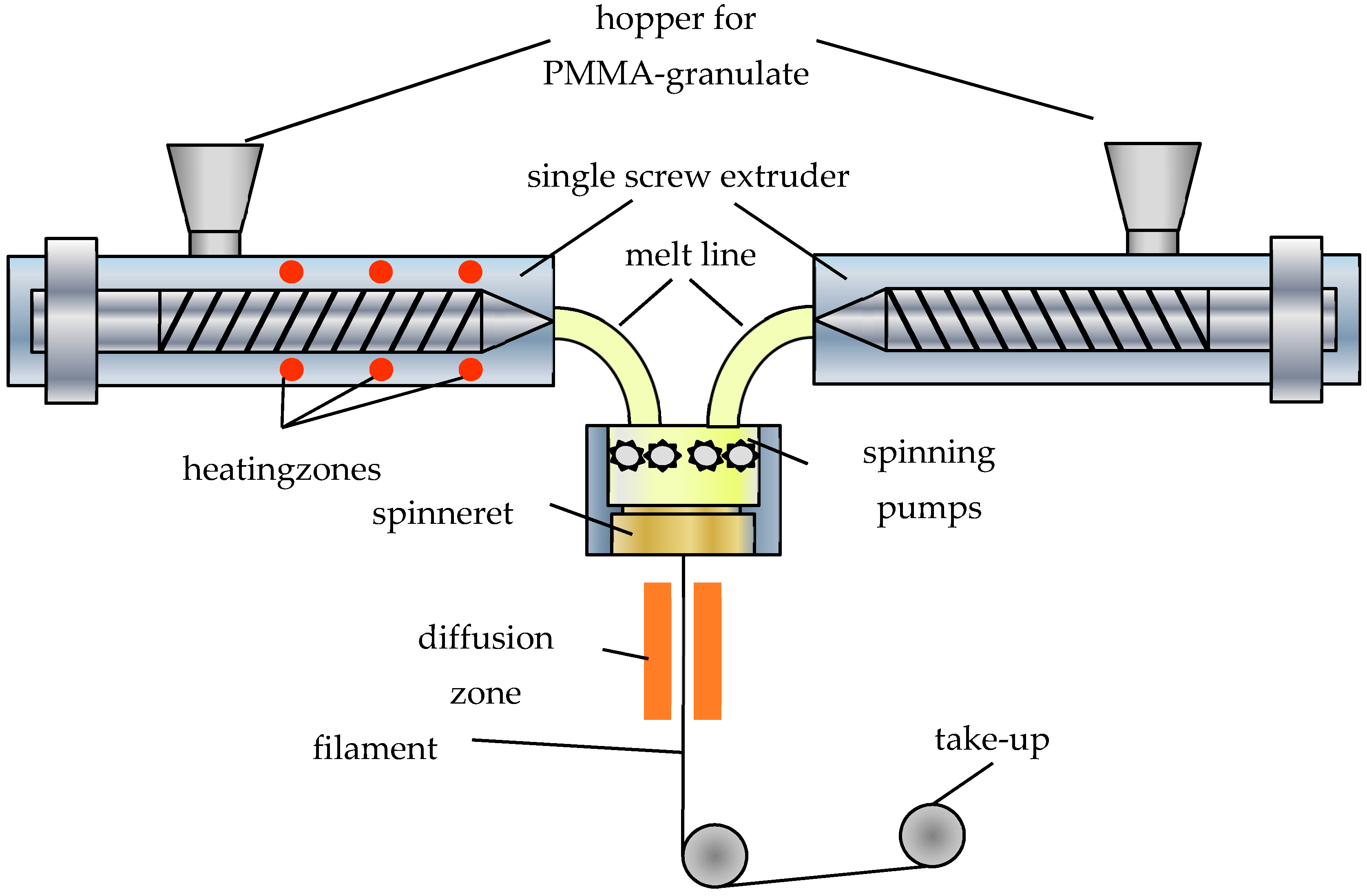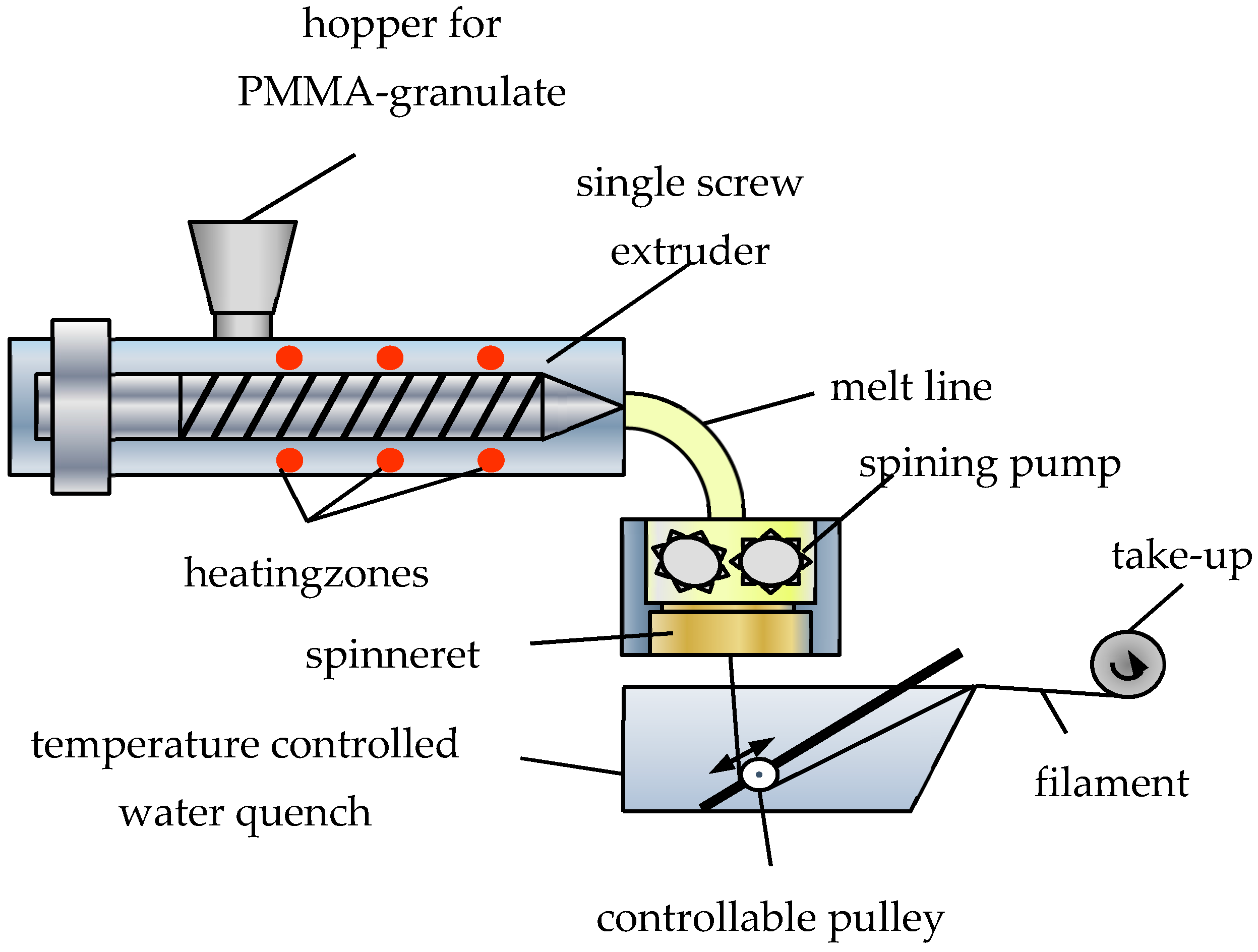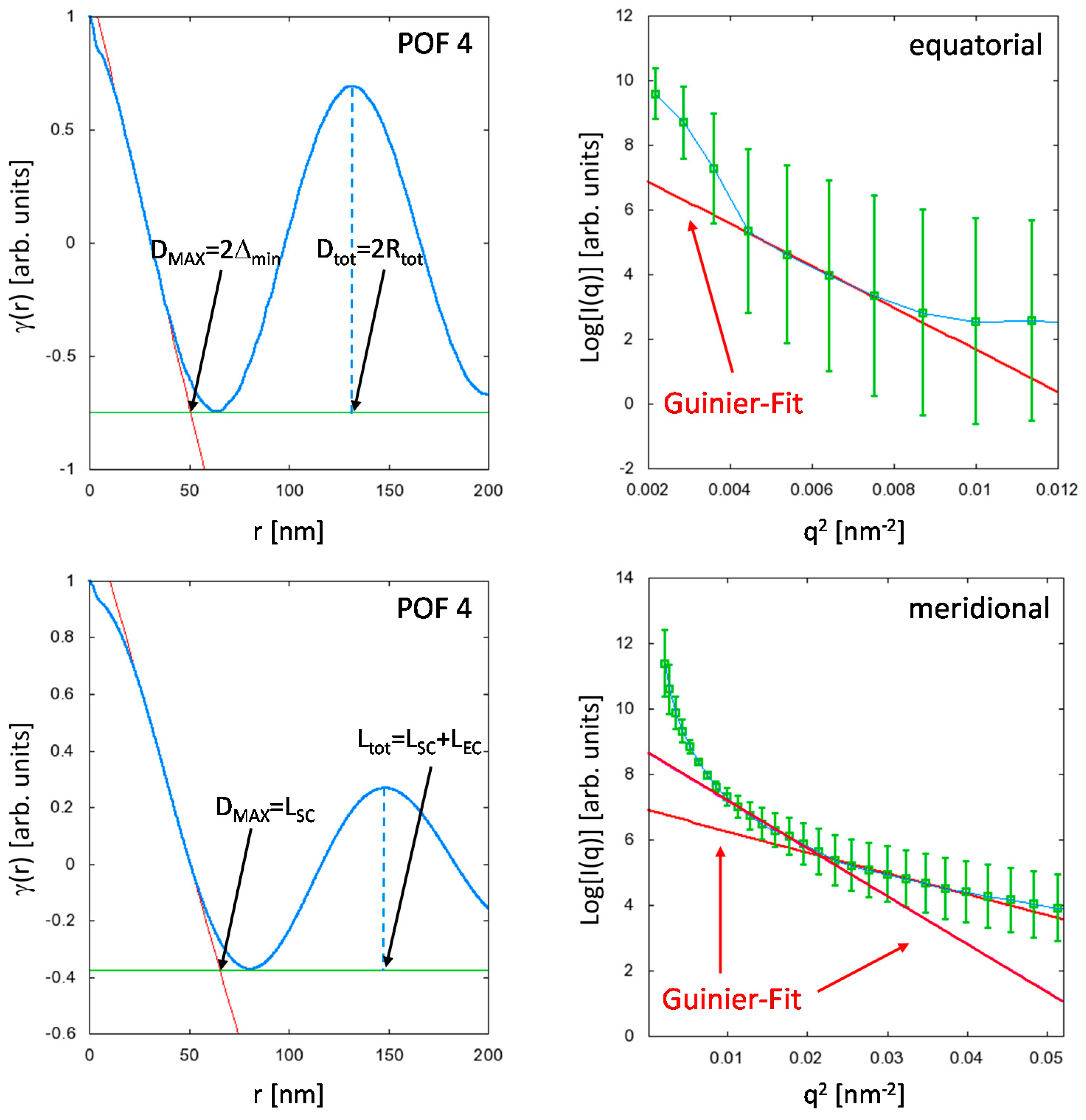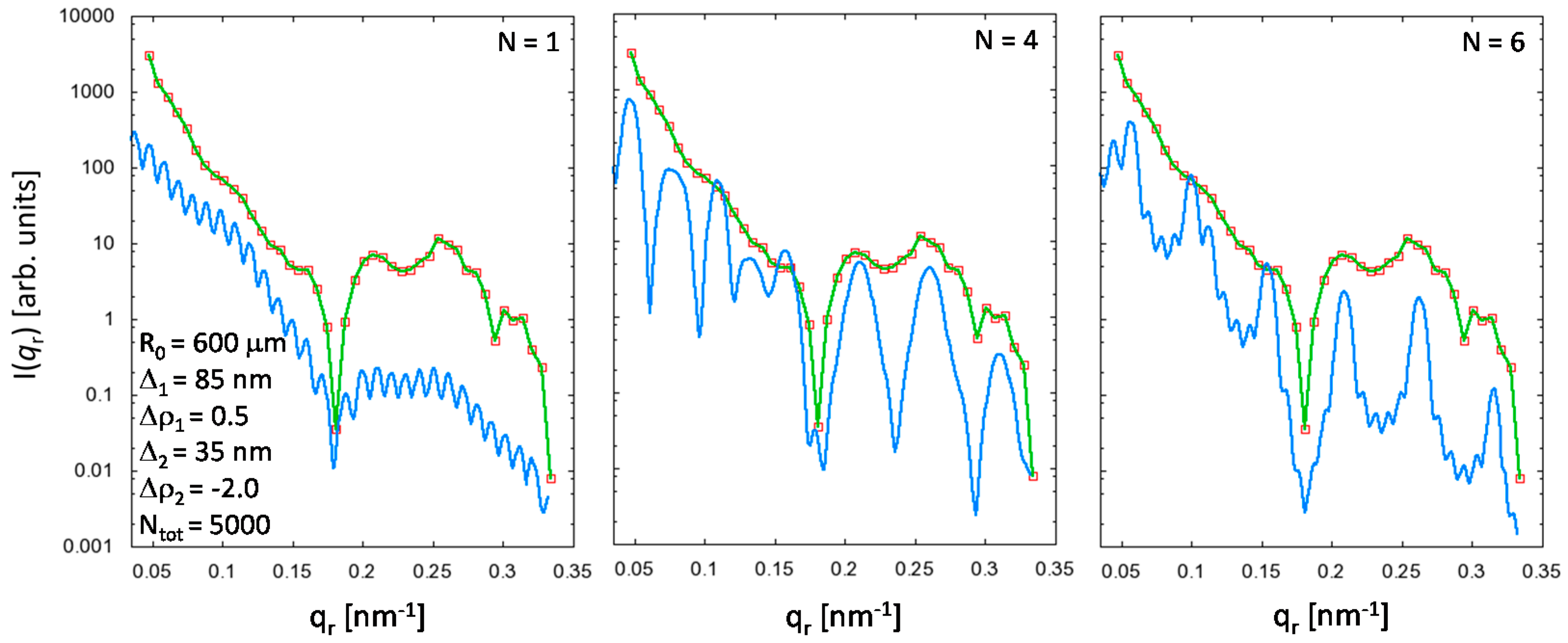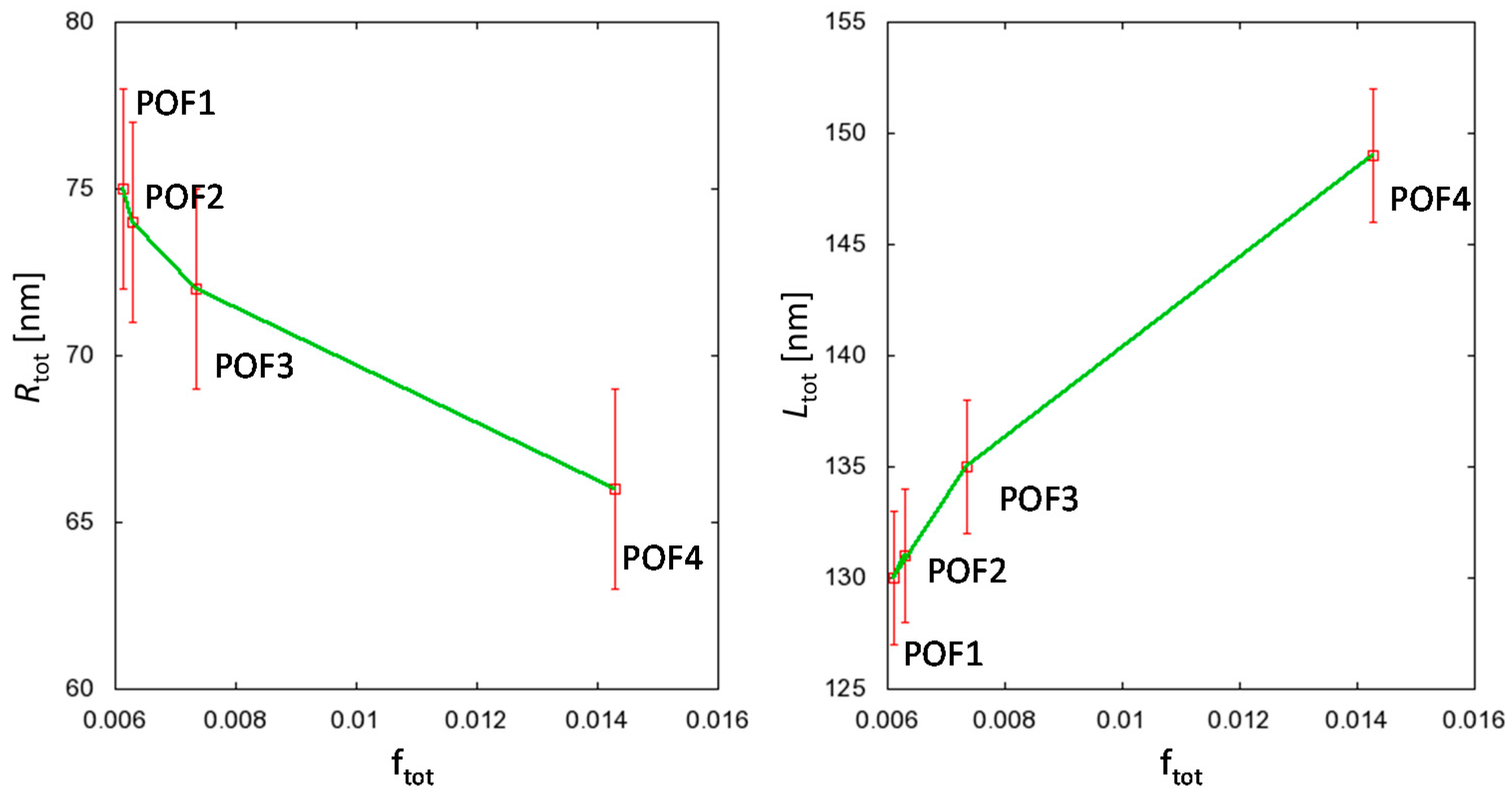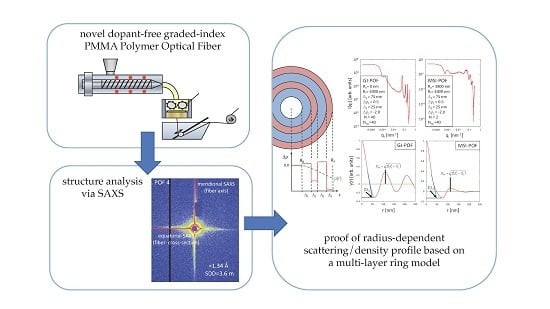1. Introduction
Polymer optical fibers (POF), mostly made from poly-methyl methacrylate (PMMA), provide a robust and cost-effective alternative to glass fibers for short-reach data communication, but also in illumination and sensing applications [
1]. Their main advantage is the relatively large diameter of up to several millimeters, which makes handling much easier than with tiny glass fibers of only several tens of micrometers, but requires different, continuous fabrication techniques. Depending on the kind of application, POFs should show different properties, such as low attenuation, controlled scattering, or a high bandwidth for data communication. Especially for the latter, graded-index (GI) fibers have been developed that feature decaying refractive-index profiles towards the outer regions of the fiber [
2,
3,
4]. This requires special fabrication methods that most often involve a discontinuous preform process, by which a large version of the fiber with the correct refractive-index distribution is manufactured first and then drawn to a fiber in a second step [
5].
In [
6], we presented a novel, continuous fabrication process, where the graded-index fiber is produced by a simple melt-spinning process without the use of any dopants to control the refractive index. The refractive-index profile is obtained by a subsequent rapid cooling of the filament right behind the spinning nozzle (see
Figure 1). The different cooling speeds of the inner and outer regions lead to a radial density distribution, which results in a refractive-index profile without the use of any doping materials.
We could show already in [
7] that the novel fabrication process without any doping materials can still lead to graded-index fibers with a distinct refractive-index profile. There are several established methods for the characterization of the refractive-index profile of fibers beginning with quantitative phase microscopy over the transmitted to the refracted near-field methods (RNF) to name just a few [
8]. However, while the formation of a refractive-index profile by pure temperature treatment after the melt-spinning process could be proven, it has not been possible to provide evidence that this profile arises due to a density gradient and how the density is distributed within the fiber.
Surprisingly, the application of these methods to PMMA POFs produced by the aforementioned melt-spinning process determine the refractive-index profiles typical for GI-POFs although the POFs do not contain any dopants such as, e.g., bromobenzene, benzyl butyl, benzyl benzoate, phenyl sulfide, monomer additions, nanoparticles, such as TiO
2 or fluorine, that are usually added to increase or decrease the refractive index over the cross-section of a POF according to their concentration levels [
9,
10,
11,
12]. The only reasonable explanation for the presence of a refractive index profile in a neat PMMA POF is the formation of a radial density gradient during the melt-spinning process, since both quantities are related to each other as described by the Clausius-Mossotti relation [
13]:
where
ρ is the density,
M = 100.12 g/mol is the molar mass of PMMA,
ρmol = 24.751 × 10
−6 m
3/mol is the molar refractivity,
n is the refractive index, and
r denotes a possible dependence of the respective quantities on the radial distance
R from the center of the fiber cross-section.
So far, a genuine proof of radial density gradients in the neat PMMA POFs is lacking. In order to obtain information on the origin of the measured refractive-index profiles, small-angle X-ray scattering (SAXS) was chosen, since this technique is ideally suited to detect density fluctuations on the nanoscale in the investigated material [
14]. Since PMMA of optical grade is basically an amorphous polymer, SAXS experiments on neat PMMA POFs have not yet been performed (mainly) due to the fact that an amorphous material normally does not exhibit any small-angle scattering. Therefore, the present work is to be understood as an initial, explorative study to assess the possibility of detecting and verifying material density profiles over the fiber diameter via SAXS experiments.
The article is structured as follows: firstly, the materials and the novel fabrication method are described in detail in order to draw conclusions on the structural properties of the resulting fibers. Subsequently, the SAXS method is introduced and experimental conditions, as well as data-analysis techniques, are explained. The results are discussed, and the fundamental assumptions for the analysis of the SAXS curves are adapted in order to explain the structure parameters obtained from the different analysis methods. In summary, the results indicate the presence of cross-sectional density variations and, consequently, the general applicability of the SAXS method for the characterization of refractive index/density profiles in POFs.
2. Melt-Spinning Fabrication Process with Subsequent Cooling
Polymer and polymer fiber processing: Polymer optical fibers can be fabricated either by continuous or discontinuous processes, while continuous processes are the norm due to their low cost [
15]. Usual continuous methods are extrusion, photo polymerization, and melt spinning. The first two processes generate the polymer during the fiber extrusion by polymerization that relies either on heat or light. The melt-spinning process, in contrast, uses already-fabricated polymer that is molten in order spin a fiber from that material (
Figure 1).
Since all process steps can be performed simultaneously it is possible to continuously generate a fiber of arbitrary length, i.e., the fiber can be produced without stops and therefore at extremely low cost. These processes are, however, not suitable for GI-POFs since each nozzle extrudes, more or less, homogeneous material of a specific refractive index without any profile. Therefore, one has to introduce a radius-dependent inhomogeneity.
Most processes for graded-index fibers are discontinuous preform techniques, in which the preform of the fiber is produced first and then drawn to a fiber in a second step. Since these steps have to be performed sequentially, only a fiber of limited length can be drawn from the preform, which makes this method more expensive.
To achieve the graded-index profile in a continuous process, we used the melt-spinning technique with a subsequent rapid cooling in a water quench, which is supposed to introduce a radius-dependent cooling speed [
16].
Figure 2 explains the process in detail. Using this continuous fabrication method, the fiber length is not limited. The main difference to the standard melt spinning is the water quench just after the spinning when the fiber is still warm and close to the glass-transition temperature.
With control of the cooling in the water quench, the refractive-index profile of the produced fiber can be engineered in a simple way using standard off-the-shelf production methods. The decrease of cooling speeds from the outer regions towards the fiber axis results in a density gradient with an increase of the density for lower cooling speed in the center of the fiber. This increasing density towards the fiber axis leads to a refractive-index profile according to the Clausius-Mosotti relation because of the larger number of polarizable material per volume. This density-gradient formation within the fiber, however, has not directly been proven. For this reason and because variations of the density can also lead to increased scattering [
17], a study of the structural properties of these novel fibers have been conducted.
For the following study, fibers are spun from the amorphous optical grade PMMA PLEXIGLAS® (Evonik Performance Materials GmbH, Darmstadt, Germany), Pure Optical Quality (POQ) with different process parameters, such as nozzle diameter, water and process temperature, and winding and extrusion speed.
4. Results and Discussion
For the four selected POF samples, a significant SAXS signal is detectable (see
Figure 4) which basically confirms the presence of density variations in the amorphous PMMA fibers. Moreover, the significant differences in the 2D SAXS intensity distributions of the fibers demonstrate the influence of the processing conditions on the PMMA fiber nanostructure. The intensity streaks in the equatorial plane (corresponding to the fiber cross-section) and the meridional direction (corresponding to the fiber axis) appear to be quite sharp and indicate a high degree of axial orientation of the observed nanostructure. Since the major changes in the scattering intensities also take place perpendicular and parallel to the fiber axis, the respective equatorial and meridional intensity contributions were extracted (
Figure 5) in order to facilitate the analysis by methods that are usually applied to 1D scattering curves—the Guinier approach and the distance distribution function [
14]. Both methods have the advantage, that a particular nanostructure model is not required for the analysis of the SAXS data.
From the Guinier analysis, the forward scattering intensity
I0 and the radius of gyration
Rg are obtained by fitting a model function:
to the measured low-
q scattering data
Iobs(
q). Since the fiber scattering exhibits cylindrical geometry [
23], possible density fluctuations across the fiber diameter may be of cylindrical shape as well, and, therefore, the radius of gyration resulting from the Guinier fit of the equatorial scattering curve can be interpreted as a cylinder radius
Rc which is related to
Rg by:
Correspondingly, the Guinier analysis of the meridional scattering curve yields a cylinder length
Lc where:
The obtained values can be cross-checked by computation of the Fourier transform of the scattering intensities, i.e., the equatorial and meridional 1D Patterson (distance distribution) function
and
with
where
qr and
qz are the momentum transfer vector components in the equatorial plane (fiber cross-section) and along the fiber axis, respectively, and
J0 is the zero-order Bessel function of the first kind. In order to suppress series termination ripples arising from the limited
q-range, a damping function
M(
qz/r) = exp[−
B2q2z/r] is used [
24,
25]. The constant
B is chosen such, that
M(
qz/r) = 0.05 at
qz/r = 0.2 nm
−1. The analysis of the SAXS curves was carried out with self-written Fortran 90 programs. For the Guinier fits, the Levenberg-Marquardt routines MRQMIN and MRQCOF were employed [
26].
For an ideal single-particle scattering in a two-phase system, the respective maximum dimensions are obtained at the first intersection of the Patterson functions with the abscissa, i.e.:
For the more general case, the maximum dimension is determined by the intersection of the linear extrapolation of γ(
r) close to the abscissa and its first minimum [
27,
28].
The results are exemplarily shown for the sample POF4 in
Figure 6. A striking feature is the similarity between the meridional and the equatorial Patterson functions. Both functions exhibit a real-space correlation peak which is related to a periodically occurring repeat unit. The presence of these correlation peaks is a quite unusual phenomenon for a generally amorphous material. Consequently, the peaks are very likely caused by periodic (scattering-) density variations along the fiber axis, as well as over the fiber cross-section.
The meridional case is well known and has been extensively studied for the case of semi-crystalline polymer fibers [
29,
30]. Here, the maximum dimension
DMAX =
Lcryst corresponds to the axial dimension of the polymer crystallite, while the peak in the meridional Patterson function can be assigned to the so-called long-period
Ltot =
Lcryst +
Lamorph, i.e., two adjacent crystallites are separated by amorphous polymer chain segments of length
Lamorph.
Although flow- or shear-induced crystallization effects can be excluded for the PMMA fibers, melt-spinning, however, produces straight polymer chain sections of length
LSC, which—in comparison to the entangled polymer chain sections of length
LEC that separate two consecutive straight polymer sections—differ in their axial scattering densities, i.e.,
Ltot =
LSC +
LEC. These straight chain sections can be considered as amorphous shish-precursors, which finally lead for a semi-crystalline polymer to the formation of polymer crystallites [
31,
32,
33].
The sum of the lengths (
LSC +
LEC) obtained from the analysis of the two different Guinier regions (
Figure 6) agree quite well with the positions
Ltot of the correlation peaks in the meridional Patterson functions for all POF samples and demonstrate that both Guinier and real space analysis yield consistent results (see
Table 2).
The interpretation of the equatorial Patterson function is less straightforward. Similar to the meridional distance-distribution function, the equatorial real-space correlation peak indicates the presence of a radially symmetric repeat unit, which can, e.g., be defined as two concentric ring-segments of widths Δ
1 and Δ
2 that exhibit significantly different scattering density contrasts Δ
ρ1, and Δ
ρ2, respectively. Moreover, good axial transmission properties of the POFs require that the refractive index and, according to the Clausius-Mossotti Equation (1), the material density, decays with increasing distance
r from the fiber axis, which defines the general properties of the ring segments Δ
1 and Δ
2. The ring-segment of larger width (Δ
1) can be assigned a positive scattering density contrast Δ
ρ1 while the ring-segment with smaller width (Δ
2) exhibits a negative scattering density contrast Δ
ρ2 < 0. Thus, a decaying total scattering density can be achieved if |Δ
ρ1| < |Δ
ρ2|, and the moduli of the scattering density contrasts increase with the distance
r from the fiber axis (
Figure 7). In principle, this radially decaying, periodic scattering density variation over (parts of) the fiber cross-section is related to the behavior of the polymer melt along the temperature gradient in the fiber. For example, different (radial) cooling rates can lead to changes in the free volume between adjacent polymer chains, which is additionally influenced by the radial extrusion velocity profile of the polymer melt. Furthermore, internal stress, which is likely to occur in the outer rim of the fiber cross section may—in combination with the velocity profile—possibly induce ring segments of different density separated by nanoscopic cracks. Albeit the origin of such radially decaying, periodic scattering density contrast variations over (parts of) the fiber cross-section—which is clearly indicated by the equatorial real-space correlation peak—is far from being understood, the described model appears to be self-consistent, and can at least be used to correctly interpret the structural information contained in the γ
equ(
r) in terms of the model function:
where
S0 is a scaling factor,
J1 is the first order Bessel function,
N is the number of repeat units,
R0 is the radius of the fiber core with constant scattering density (i.e., Δ
ρ0 = 0),
R1 =
R0 + Δ
1,
R2 =
R1 + Δ
2,
Rk =
Rk−1 + Δ
1 if
k = 2
n − 1, and
Rk =
Rk−1 + Δ
2 if
k = 2
n. The scattering contrast Δ
ρk equals Δ
ρ1 if
Rk −
Rk−1 = Δ
1, and Δ
ρk = Δ
ρ2 if
Rk −
Rk−1 = Δ
2.
The function
f(
k,
N,
NR0) increases the moduli of the scattering contrasts Δ
ρk with increasing
k, i.e.:
where
NR0 is the number of repeat units that fit into the radius
R0, i.e.,
NR0 =
R0/(Δ
1 + Δ
2), and
Ntot is the total number of repeat units for a fiber with radius
Rf, i.e.,
Ntot =
Rf/(Δ
1 + Δ
2).
Equation (9) is a very simple approach to the above described model and is in its current form not applicable to fit the observed equatorial SAXS data. The development of a suitable model—similar to the one known for stacked platelets [
34]—requires much more effort in order to separate the single repeat unit scattering (i.e., the “single-particle” scattering) from the structure factor that describes the scattering contributions arising from the interference of different repeat units, which is necessary to introduce corrections such as, e.g., size-distribution functions for the repeat units, and uncertainty factors for the inter-particle scattering into the model scattering function. Nevertheless, the model curves demonstrate that the information content in the equatorial Patterson function is basically the same for a GI-POF (where the density variation starts at
R0 = 0 nm) or a multi-step index (MSI)-POF (where the density variation starts for the example structure at
R0 = 3800 nm, see
Figure 7).
The
DMAX value corresponds to the doubled width of the smaller ring-segment, i.e.,
DMAX = 2Δ
min = 2
Δ2 and the position of the correlation peak
Dtot is given by:
The comparison of the values
Rtot =
Dtot/2 with the results for the cylinder radii
Rc obtained from the Guinier analysis (see
Table 2) agree almost perfectly for all four POF samples, which demonstrates, once again, that the results are consistent, and, more important, that the above described equatorial structure model is a simple but reasonable approach to the real nanostructure of the POFs over the fiber cross-section.
A simple simulation using Equation (9), where the parameters
Δ1 = 85 nm and
Δ2 = 35 nm were manually found by variation of the respective values derived from the equatorial Patterson function within their uncertainties, was carried out for the sample POF1 which displays the most pronounced features in the equatorial scattering curve (see
Figure 8). Although the model scattering intensities can of course not even rudimentarily describe the measured data, it can yet be shown that the maxima and minima in the observed intensities are correctly reproduced and that the sample is a multi-step index fiber rather than a single-step or gradient-index POF (which is presumably valid for all four investigated PMMA POF samples).
The upturn of the measured SAXS curve at very small
q-values in comparison to the model curve (
Figure 8) may either be indicative of additional scattering contributions arising from micro cracks or gas-inclusions, which also need to be taken into account for a proper data modeling, and/or can be attributed to an incorrectly chosen fiber core radius
R0 (see the SAXS curves in
Figure 7). To access information on such large-scale structure features for an improved interpretation of the results (for both equatorial and meridional scattering intensities) requires an extension of the experiments into the ultra-small-angle X-ray scattering (USAXS) regime, i.e.,
q ≤ 10
−2·nm
−1, making use of appropriate techniques such as, e.g., light scattering and/or USAXS-cameras (Bonse-Hart) [
35,
36]. Regardless of these limitations, the comparison between model curve and observed data clearly demonstrates that the parameters derived from Guinier and real-space analysis are related to the PMMA nanostructure rather than to scattering contributions originating from cracks or voids. This indication can in principle be easily confirmed if the structure parameters show systematic dependencies on the processing conditions. Moreover, strong correlations between process and structure parameters are a clear sign that the polymer structure, and, in particular, the radial density profile, can be modified by changes in the fiber production process.
As already mentioned above, single process parameters were not systematically varied in this study. However, since the overall characteristics for the production of the four fiber samples are different, at least integral structure—process relationships can be obtained, which require the definition of an overall process parameter that (qualitatively) reflects the interdependencies of the complete set of production factors with respect to their relative impact on the formation of the fiber structure.
The variation of the spin-draw ratio λSD has a strong influence on the structure of a fiber material that is rapidly cooled down, and almost no influence on the structure of a fiber in the molten state. Consequently, it appears reasonable to weight the spin-draw ratio λSD with the temperature of the water-bath Twater. This argument also holds for the mechanical draw ratio λD, which can be weighted with the drawing temperature TD. The effect of the applied mechanical draw ratio λD on the fiber structure also depends on the history of the as-spun material, since the relative impact of the draw ratio on the fiber nanostructure is higher if the fiber is spun at a moderate spin-draw ratio, and decreases with increasing spin-draw ratio.
Thus, an approximate overall process parameter
ftot can be created which is given by:
where
T0 corresponds to ambient temperature. The overall factor
ftot defined by Equation (12) has to be considered as a very simple approximation to the real dependencies of the single process parameters. Though the major changes in the integral structure parameters are due to the mechanical draw ratio (which is in fact of minor importance for the fabrication of POFs, see
Table 1),
Figure 9 reveals that
Rtot and
Ltot depend (even for the comparatively small changes in the process parameters between POF1 and POF2) systematically on
ftot, which proves that the equatorial (scattering-) density, as well as the meridional length distribution of the straight PMMA chain segments in the fiber, can be manipulated by selection of the processing conditions.
